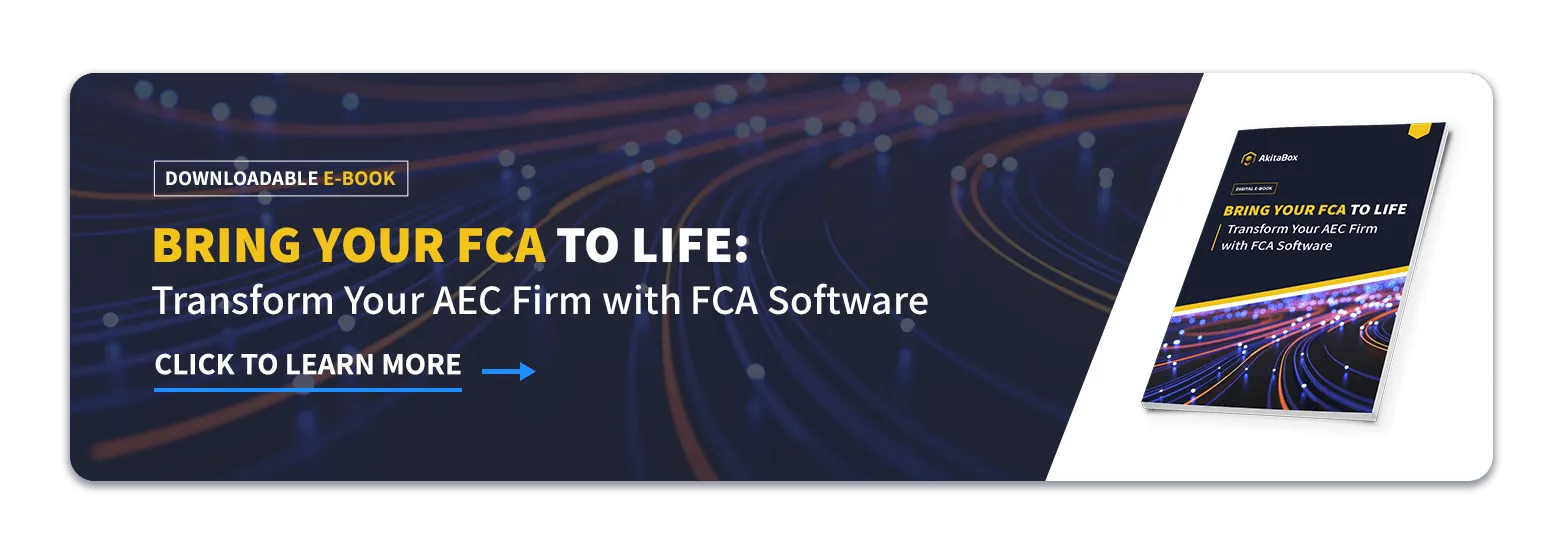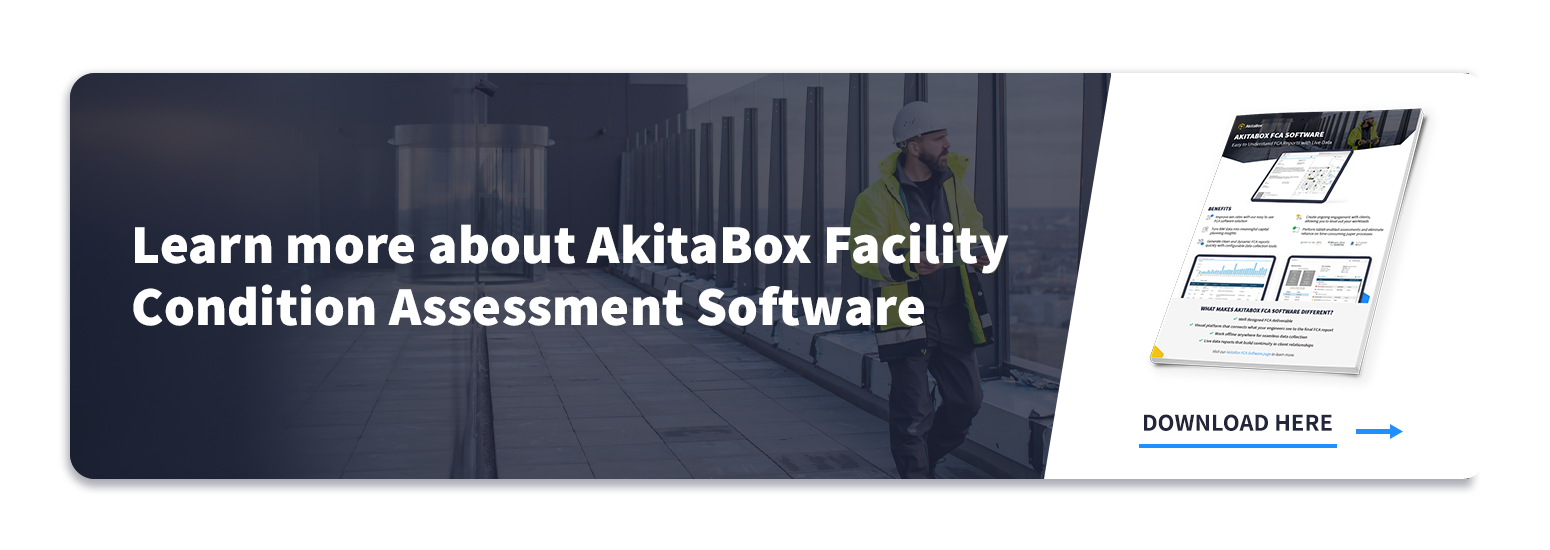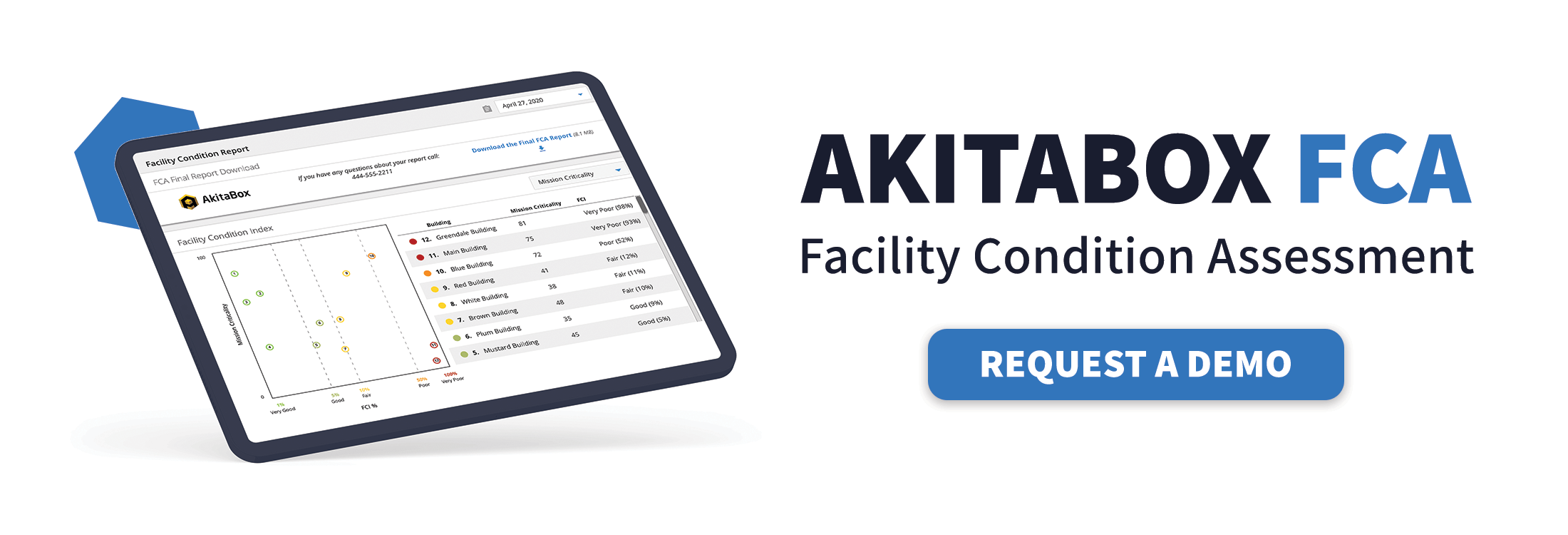For many AEC firms, facility condition assessments are often an afterthought or given away in order to earn future design and construction work.
It’s understandable. Considering the lack of innovation in the FCA space, delivering value in an FCA that lasts beyond the report has been challenging. Since most are done using spreadsheets and other legacy tools, it’s safe to say the FCA has pretty much been left behind by technology developers. Until now.
At AkitaBox, we’re innovating the FCA to solve the problems with the traditional way of conducting them. Investing in new technology for your FCAs is a smart move – and it can bring lasting returns to your business.
Here are 4 questions to ask yourself that can help you frame up what the ROI of investing in a good FCA software tool can look like for your firm.
Question 1: What are the risks of sticking with the way I’ve always done FCAs?
About the only advantage to not changing is … you don’t have to do the work of changing. Staying with your FCA status quo is risky for many reasons.
Too much time spent on mundane, administrative tasks
Imagine you just spent two weeks assessing a million square feet. Now you’re back in the office sorting through a mountain of photos and notes trying to remember which building you started in. It’s a nightmare – I know, I’ve done it. Think of how much time you’re spending downloading photos, sorting photos into different folders, and copying your notes into the computer. Now think about how much faster you could be and how much more work you could accomplish if you didn’t have to be doing those tasks for every FCA.
Data loss
There’s nothing worse than getting back to the office after visiting the customer site and realizing you forgot information. Or maybe you accidentally deleted your Excel file. Or your laptop gets stolen at the airport. Even if you upload your data to an FTP site, you’re not out of the woods. What if you dropped your ipad before you could connect to the internet? The risk of losing assessment data is ever present.
Not having normalized data
Accurate, standardized data is essential in FCAs. But tools like Excel won’t stop you from making typos or inputting incorrect information. Those mistakes add up quickly and can mess up your reports. You want a tool that normalizes how you collect and organize information so you can maintain data consistency.
No standard in-house FCA process
In most organizations, your FCA is going to look like whatever a particular project manager wants it to look like. Sure, your firm may have some general guidelines, but when it comes down to it, one person likes assessing things this way and another prefers that way. What happens in those situations is you can’t run data from multiple FCA projects against each other because every one is somewhat different.
| The bottom line is: if you don’t change, you’ll always get the same result. The old, traditional way of doing FCAs sets you up to be inefficient and ineffective. |
Question 2: What if I could turn FCAs into more of a revenue generator for my firm?
In the last 5 years, I’ve noticed building owners and operators are seeing more value in FCAs. They’re transitioning away from free FCAs and towards paid assessments done by experienced professionals that provide real long-term value.
Why couldn’t you harness this trend?
A good software tool can help you capture more FCA opportunities and gain market share by:
- Making you more competitive (You could be losing work because of the inefficiencies of your old process. With a better process, you can compete for work you wouldn’t have been able to before.)
- Delivering an interactive FCA of real worth to your client
- Increasing your value to your clients
- Building stronger, longer-term relationships with clients
Question 3: What cost savings or efficiencies can my firm see with FCA software?
Investing in truly innovative tools can transform your FCA process. And that can bring a ripple effect of advantages to your firm.
- Time savings. There are three areas where you spend time in an FCA: onsite data collection, offsite data collection, and building reports. If you could save even 20% of your onsite time and 20% of your offsite time on every FCA with a better tool, that’s a huge amount of reclaimed time that could be spent on other initiatives.
- Better labor forecasting. Bringing in more FCA business can provide revenue and work hours in between larger projects, keeping your engineers busy even during slower times.
- Improved use of existing labor. Instead of downloading photos and entering data, your highly skilled engineers can focus on evaluating data and generating recommendations – tasks better suited to their experience.
- Decreased risk of forgetting, losing data. Like I mentioned above, there’s always a risk of losing site data one way or another. FCA software keeps all of your data in one place, allowing you to easily input data right as you collect it.
- Higher data quality. An FCA tool keeps you from coloring outside the lines by ensuring you enter all necessary information correctly before letting you move on. This sort of automation delivers greater accuracy and prevents incomplete records.
- Better processes. Besides reducing or outright eliminating time-consuming tasks like data entry, FCA software can also ensure more consistent data collection and reporting throughout the organization.
- Simplified onsite data collection. An FCA tool like AkitaBox FCA lets you take a photo of an equipment’s information tag – it then reads the text from the photo and automatically enters it into the system. That’s just one of many ways an FCA tool can make data gathering go more quickly and accurately.
- Faster offsite data organization with automation. In the simplest terms, an FCA is just a lot of data entry and data validation. Why not let a technology tool do what it’s good at (entering and organizing data) so the engineers can do what they do best (use their industry knowledge and experience to review and confirm the FCA information is accurate)?
Question 4: How can I calculate an exact ROI for FCA software?
Determining what that number looks like for your firm depends on a few factors, including:
- If you’re using Excel vs. a software solution
- What your current processes are
- How many square feet of FCAs you conduct
- How much of your business comes from FCAs
- And more
It’s not as simple as plugging a bunch of numbers into a spreadsheet. Giving you a real idea of how much return you could see requires a more nuanced approach. We do that by meeting with you to learn more about your particular firm and gathering the necessary information. From there, we can walk you through the various ways FCA software can save you time and money.
So if you’re ready to learn how FCA software can benefit your firm (and your clients), let’s find out what your ROI could be. Get started here.




